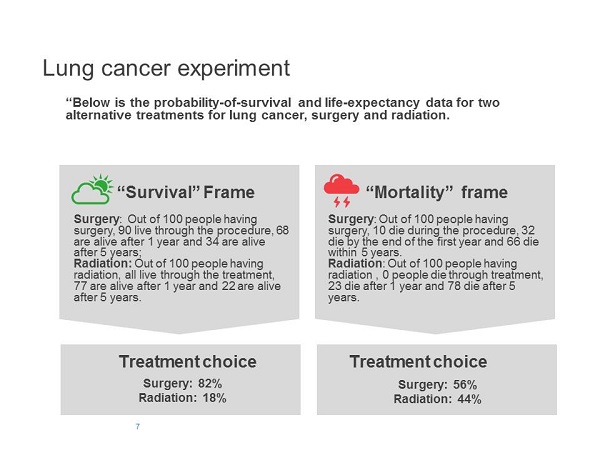Promoting new drugs: learnings from behavioural economics

Following on from her first article investigating how physicians make decisions, Theano Anastasopoulou explains how cognitive biases can influence the ways new drugs are promoted.
What is the best way to support a new drug launch? Its success depends on a coordinated effort from various teams, including marketing and branding. The latter are responsible for the communication of the product benefits and the development of promotional materials.
Behavioural economics, which has its roots in psychology and studies the cognitive mechanisms that underlie decision making 1, 2 and behaviour 6, can provide valuable insights when designing such a campaign.
Framing
Framing is a bias that describes how different ways of presenting the same information can have an effect on choice. Decision makers' preferences can be influenced by the way in which information for different options is formulated. When outcomes are framed in terms of gains, such as saving lives or winning money, people are risk averse and choose a certain gain rather than a possible but uncertain larger gain; in contrast, in the domain of losses, with outcomes such as losing lives or money, people tend to seek risk by avoiding a certain loss, even if an uncertain gamble might result in an even larger loss. In other words, individuals are more willing to accept risk when they perceive something as a potential loss, and they tend to avoid risk when they perceive a potential gain 7.
Research on framing frequently uses medical examples. A good one is the Asian disease experiment 7 where information about a disease was presented in two different ways (Figure A).

Figure A
Two groups were asked to choose between the two programs within each frame. Although the programs described exactly the same outcomes, the different frames resulted in a reversal of the preferred choice. Over 70% of the sample chose Program A over B in the 'gains' frame, and Program B over A in the 'loss' frame.
When the problem is framed in terms of gains, the reference point is 'no lives are saved' and the options are evaluated versus this. When the program is framed in terms of losses, the reference point is 'no lives are lost' and the options are evaluated versus this. In the gains frame most decision makers choose the less risky option, while in the loss frame most decision makers choose the more risky option. Being risk-averse in gain domains and risk-seeking in loss domains has been demonstrated in many different contexts.
In another example, McNeil et al. 3,4 asked participants to imagine that they had lung cancer. They were given probability-of-survival and life-expectancy data for two alternative treatments, surgery and radiation. For half the participants, the data were presented in a positive, or 'survival', frame, while half received the data in a negative, or 'mortality', frame (Figure B).

Figure B
Participants preferred radiation therapy to surgery 44% of the time in the mortality frame, but only 18% of the time in the survival frame. In other words, the advantage of radiation therapy was greater when stated in terms of risk of imminent death than when expressed in terms of increased survival. Interestingly, McNeil et al. 3 found that doctors were just as susceptible to the framing effect as non-medical participants (patients and students). However, further research also showed that this effect may be less pronounced when doctors make decisions for their patients versus when they make decisions for themselves and may be difficult to replicate across other possible scenarios.
The implication for drug promotion is that, if a new product is offering efficacy gains but is also associated with higher risks, adopting a 'gains' framing at promotion may fail to achieve its full potential because of this bias. If a new product is associated with a lower risk, adopting a 'gains' frame will lead to better results. It is worth including a test of different framing alternatives when testing promotional materials in market research.
Familiarity and cognitive ease
Another very well established bias that would work against new drugs is related to the greater acceptance of existing product messages due to familiarity. Obviously this is common knowledge, but behavioural economics research can help us understand how this bias works and could be managed. It tells us that repetition of a message increases familiarity and a feeling of cognitive ease. Cognitive ease results from a reduction in the perceived cognitive effort associated with a task, and it is likely to increase the acceptance of and preference for a message and product. A 'mere exposure effect', which is essentially just exposing someone to a brand name or message, is a well-documented finding. In a classic experiment, random Turkish words appeared in a university publication in the US without any context or explanation. In a later test with students of the university, the words that appeared more times in consecutive publications were rated more favourably than those that appeared less frequently 8. There was no other reason for a favourable rating of these random words other than familiarity. In addition, those words did not have to be consciously remembered to be rated more favourably.
This established bias towards existing products has implications for the messaging of new products, which start at a disadvantage to familiar products. However, if the message of the new product can be strongly linked by logic or association with beliefs already held, or with a source that is trusted, it is more likely to be accepted. This is because it would then automatically generate a feeling of familiarity and a higher likelihood of acceptance of the message. So reinforcing associations with strong existing beliefs or needs is a good way to cut through with a new message.
In addition, priming of a message, which is an activation of relevant established information or content, is likely to increase the cognitive ease with which the message is processed, as well as the acceptance and believability of it. For this to be effective it is important that any priming is not conscious and that it happens without the recipients' realising that they have been primed. Presenting a current, well-established need of the recipient, for example, followed by how the new product addresses it, is likely to facilitate a favourable perception.
Even very basic principles on the presentation of a message can be used to strengthen the effect of familiarity. Anything that makes a message easier to read will facilitate acceptance and credibility by increasing cognitive ease, for example clear print, high-quality paper, maximising the contrast between characters and the background, or clearly presented tables and charts. Typical ratings of clarity or credibility obtained by market research essentially tap into feelings of cognitive ease and strength of association with established beliefs and should be an essential part of promotional material testing. New techniques like eye-tracking, biometrics or electroencephalogram (EEG) measurements can also help in understanding the degree to which materials can lead to feelings of cognitive ease and help design new messages that can successfully compete with established brands.
References
1 Ariely, D. (2010). Predictably irrational: the hidden forces that shape our decisions. New York, Harper Perennial.
2 Kahneman, D & Tversky, A, (1979). Prospect Theory: An Analysis of Decision under Risk. Econometrica, Vol. 47, No. 2, 263-292.
3 McNeil B J, Pauker S G, Sox H C & Tversky A. (1982). On the Elicitation of Preferences for Alternative Therapies. The New England Journal of Medicine; 306:1259-1262.
4 McNeil, B J, Pauker, S G, Tversky, A. (1988). On the framing of medical decisions. Bell, D E (Ed), Raiffa, H (Ed), Tversky, A (Ed). Decision making: Descriptive, normative, and prescriptive interactions (pp. 562-568). New York, NY, US: Cambridge University Press.
5 Murphy, S T & Zajonc, R B (1993). Affect, cognition, and awareness: Affective priming with suboptimal and optimal stimulus. Journal of Personality and Social Psychology, 64, 723–739.
6 Thaler, R H & Sunstein, C R. (2009). Nudge: improving decisions about health, wealth, and happiness. New York, Penguin Books.
7 Tversky, A & Kahneman, D. (1986). Rational choice and the framing of decisions. Journal of Business, 59, S251-S278.
8 Zajonc, R B (1968). Attitudinal effects of mere exposure. Journal of Personality and Social Psychology, Supplement 9 (2, Pt. 2), 1-27.
9 Zajonc, R B (1980). Feeling and thinking: Preferences need no inferences. American Psychologist, 35, 151-175.
About the author:
Dr Theano Anastasopoulou is a group director in the Advanced Methods team at life science market research company Kantar Health. She is primarily responsible for providing consultancy and methodological support in the design and analysis of market research programmes. Dr Anastasopoulou consults on optimal methodologies, testing new products, marketing materials, branding strategies and customer segmentation.
She has 20 years' research experience as an analyst and market research methodologist and holds a PhD in Cognitive Psychology from University College London.
Read the first part of this two-part series:











